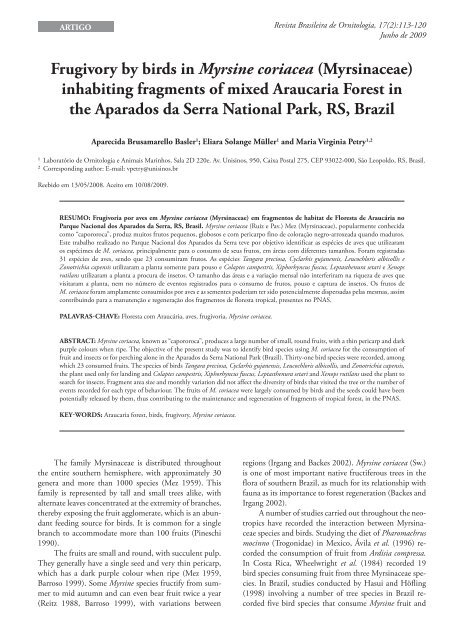art01 - omena júnior.indd - Sociedade Brasileira de Ornitologia
art01 - omena júnior.indd - Sociedade Brasileira de Ornitologia
art01 - omena júnior.indd - Sociedade Brasileira de Ornitologia
- No tags were found...
Create successful ePaper yourself
Turn your PDF publications into a flip-book with our unique Google optimized e-Paper software.
ARTIGO Revista <strong>Brasileira</strong> <strong>de</strong> <strong>Ornitologia</strong>, 17(2):113-120Junho <strong>de</strong> 2009Frugivory by birds in Myrsine coriacea (Myrsinaceae)inhabiting fragments of mixed Araucaria Forest inthe Aparados da Serra National Park, RS, BrazilAparecida Brusamarello Basler 1 ; Eliara Solange Müller 1 and Maria Virginia Petry 1,21 Laboratório <strong>de</strong> <strong>Ornitologia</strong> e Animais Marinhos, Sala 2D 220e. Av. Unisinos, 950, Caixa Postal 275, CEP 93022‐000, São Leopoldo, RS, Brasil.2 Corresponding author: E‐mail: vpetry@unisinos.brReebido em 13/05/2008. Aceito em 10/08/2009.RESumo: Frugivoria por aves em Myrsine coriacea (Myrsinaceae) em fragmentos <strong>de</strong> habitat <strong>de</strong> Floresta <strong>de</strong> Araucária noParque Nacional dos Aparados da Serra, RS, Brasil. Myrsine coriacea (Ruiz e Pav.) Mez (Myrsinaceae), popularmente conhecidacomo “capororoca”, produz muitos frutos pequenos, globosos e com pericarpo fino <strong>de</strong> coloração negro-arroxeada quando maduros.Este trabalho realizado no Parque Nacional dos Aparados da Serra teve por objetivo i<strong>de</strong>ntificar as espécies <strong>de</strong> aves que utilizaramos espécimes <strong>de</strong> M. coriacea, principalmente para o consumo <strong>de</strong> seus frutos, em áreas com diferentes tamanhos. Foram registradas31 espécies <strong>de</strong> aves, sendo que 23 consumiram frutos. As espécies Tangara preciosa, Cyclarhis gujanensis, Leucochloris albicollis eZonotrichia capensis utilizaram a planta somente para pouso e Colaptes campestris, Xiphorhyncus fuscus, Leptasthenura setari e Xenopsrutilans utilizaram a planta a procura <strong>de</strong> insetos. O tamanho das áreas e a variação mensal não interferiram na riqueza <strong>de</strong> aves quevisitaram a planta, nem no número <strong>de</strong> eventos registrados para o consumo <strong>de</strong> frutos, pouso e captura <strong>de</strong> insetos. Os frutos <strong>de</strong>M. coriacea foram amplamente consumidos por aves e as sementes po<strong>de</strong>riam ter sido potencialmente dispersadas pelas mesmas, assimcontribuindo para a manutenção e regeneração dos fragmentos <strong>de</strong> floresta tropical, presentes no PNAS.PalAVRAS-ChAVE: Floresta com Araucária, aves, frugivoria, Myrsine coriacea.ABStRACt:Myrsine coriacea, known as “capororoca”, produces a large number of small, round fruits, with a thin pericarp and darkpurple colours when ripe. The objective of the present study was to i<strong>de</strong>ntify bird species using M. coriacea for the consumption offruit and insects or for perching alone in the Aparados da Serra National Park (Brazil). Thirty-one bird species were recor<strong>de</strong>d, amongwhich 23 consumed fruits. The species of birds Tangara preciosa, Cyclarhis gujanensis, Leucochloris albicollis, and Zonotrichia capensis,the plant used only for landing and Colaptes campestris, Xiphorhyncus fuscus, Leptasthenura setari and Xenops rutilans used the plant tosearch for insects. Fragment area size and monthly variation did not affect the diversity of birds that visited the tree or the number ofevents recor<strong>de</strong>d for each type of behaviour. The fruits of M. coriacea were largely consumed by birds and the seeds could have beenpotentially released by them, thus contributing to the maintenance and regeneration of fragments of tropical forest, in the PNAS.Key-Words: Araucaria forest, birds, frugivory, Myrsine coriacea.The family Myrsinaceae is distributed throughoutthe entire southern hemisphere, with approximately 30genera and more than 1000 species (Mez 1959). Thisfamily is represented by tall and small trees alike, withalternate leaves concentrated at the extremity of branches,thereby exposing the fruit agglomerate, which is an abundantfeeding source for birds. It is common for a singlebranch to accommodate more than 100 fruits (Pineschi1990).The fruits are small and round, with succulent pulp.They generally have a single seed and very thin pericarp,which has a dark purple colour when ripe (Mez 1959,Barroso 1999). Some Myrsine species fructify from summerto mid autumn and can even bear fruit twice a year(Reitz 1988, Barroso 1999), with variations betweenregions (Irgang and Backes 2002). Myrsine coriacea (Sw.)is one of most important native fructiferous trees in theflora of southern Brazil, as much for its relationship withfauna as its importance to forest regeneration (Backes andIrgang 2002).A number of studies carried out throughout the neotropicshave recor<strong>de</strong>d the interaction between Myrsinaceaespecies and birds. Studying the diet of Pharomachrusmocinno (Trogonidae) in Mexico, Ávila et al. (1996) recor<strong>de</strong>dthe consumption of fruit from Ardisia compressa.In Costa Rica, Wheelwright et al. (1984) recor<strong>de</strong>d 19bird species consuming fruit from three Myrsinaceae species.In Brazil, studies conducted by Hasui and Höfling(1998) involving a number of tree species in Brazil recor<strong>de</strong>dfive bird species that consume Myrsine fruit and
















